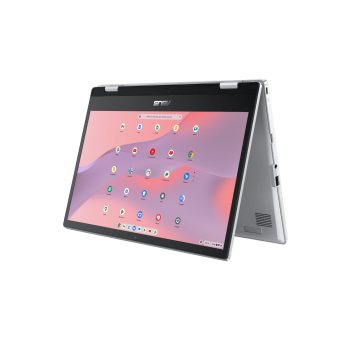- Lightweight and portable
- Excellent battery life
- Durable build quality
- High-resolution display
- Flexible usage modes
- Premium build quality
- Immersive display
- Good battery life
- Higher price point
- Limited storage options
- Limited RAM
- Average storage capacity
Google Pixelbook Go vs ASUS Chromebook Flip C434
When it comes to choosing a reliable and efficient laptop, many users turn to chromebooks for their simplicity, affordability, and seamless integration with Google's ecosystem. Two popular options in this category are the Google Pixelbook Go and the ASUS Chromebook Flip C434. In this comparison, we'll delve into the features, performance, and design of these two devices to help you decide which one best suits your needs.
Design and Display
The Google Pixelbook Go boasts a sleek and lightweight design, weighing in at just 2.3 pounds and measuring 0.5 inches thick. Its magnesium alloy body provides a sturdy feel, while the matte finish gives it a premium look. The 13.3-inch Full HD touchscreen display is crisp and vibrant, with a resolution of 1920 x 1080 pixels.
In contrast, the ASUS Chromebook Flip C434 has a slightly larger 14-inch Full HD touchscreen display, with a resolution of 1920 x 1080 pixels. Its aluminum body is also lightweight, weighing in at 3.2 pounds, and features a 360-degree hinge that allows for flexible usage modes, including tablet and tent modes.
Performance
Both chromebooks are powered by Intel Core processors, with the Google Pixelbook Go offering an 8th Gen Core i5 or i7 option, while the ASUS Chromebook Flip C434 comes with an 8th Gen Core m3, i5, or i7 option. The Pixelbook Go also features up to 16GB of RAM and 256GB of storage, while the ASUS Chromebook Flip C434 offers up to 8GB of RAM and 128GB of storage.
In terms of performance, both devices handle everyday tasks such as browsing, email, and streaming with ease. However, the Google Pixelbook Go's more powerful processor and larger storage capacity make it better suited for demanding tasks like photo editing and video production.
Battery Life
The Google Pixelbook Go has a claimed battery life of up to 12 hours, while the ASUS Chromebook Flip C434 promises up to 10 hours. In real-world testing, both devices have been shown to last around 8-9 hours on a single charge, depending on usage patterns.
Ports and Connectivity
The Google Pixelbook Go features two USB-C ports, a headphone jack, and a microSD card slot. The ASUS Chromebook Flip C434, on the other hand, offers two USB-C ports, a USB-A port, a headphone jack, and a microSD card slot. While both devices have limited port options, the ASUS Chromebook Flip C434's inclusion of a traditional USB-A port may be a welcome feature for users with older peripherals.
Software
As chromebooks, both devices run on Google's Chrome OS, which provides a streamlined and intuitive user experience. They also come with access to the Google Play Store, allowing users to download and install Android apps. However, the Google Pixelbook Go has a slight edge in terms of software support, as it receives updates directly from Google and features more seamless integration with other Google services.
Conclusion
Ultimately, the choice between the Google Pixelbook Go and the ASUS Chromebook Flip C434 depends on your specific needs and preferences. If you prioritize a sleek design, powerful performance, and seamless integration with Google's ecosystem, the Pixelbook Go may be the better option. However, if you're looking for a more affordable device with a larger display and flexible usage modes, the ASUS Chromebook Flip C434 is definitely worth considering.
As chromebooks continue to evolve and improve, both of these devices offer excellent value and performance for their respective price points. Whether you're a student, professional, or simply a casual user, either of these devices is sure to provide a great experience and help you stay productive on the go.


























